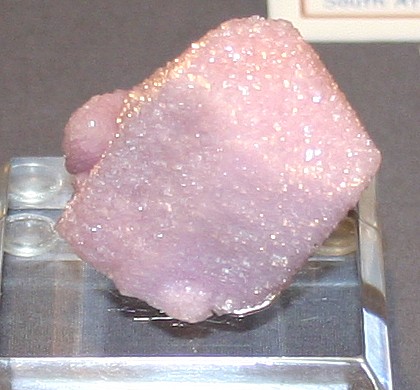|
.
Dolomite Mineral Facts:
Chemical
Formula: CaMg(CO3)2
Carbonate
of calcium and magnesium.
Colors:
Often pinkish or flesh colored, but
sometimes white, gray,
green, brown or black.
Hardness:
3.5 to 4
Slightly harder than calcite.
Density: 2.85
For Both the density and hardness
reading for aragonite are higher than normally found for calcite.
Cleavage:
Perfect rhombohedral cleavage (cleavage angle = 106 15')
Crystallography: Rhombohedral
Luster:.
Vitreous luster; pearly in
some varieties (pearl spar), transparent to translucent.
Optics:
(Refractive Index) w = 1.682; E = 1.503
|
 |
|
Composition,
Structure and Associated Minerals:
Dolomite is apparently
isomorphous with calcite but the etch figures on rhombohedral faces prove it
to belong in the trigonal rhombohedral class. It occurs as crystals and in
all the forms characteristic of calcite except the fibrous. Nearly all
calcite contains more or less magnesium carbonate, but most of the mixtures
are isomorphous with calcite and magnesite. When the ratio between the two
carbonates reaches 54.35 per cent CaCOs and 45.65 Per cent
MgCO3
, which is equal to the ratio between the molecular weights of the two
substances, or in other words when the two carbonates are present in the
compound in the ratio of one molecule to one molecule, the mineral is called
dolomite.
Identification and Diagnostics
Dolomite behaves
like calcite before the blowpipe and in the closed tube. It, however,
dissolves only slowly, if at all, in cold hydrochloric acid, except when
very finely powdered, though dissolving readily with effervescence in
hot acid. The reaction toward cold acid and its greater hardness easily
distinguish dolomite from calcite. It is distinguished from magnesite by
the flame reaction for calcium. Crystallized varieties told by its
curved rhombohedral crystals and usually by its flesh-pink color.
Occurrence,
Localities and Origins:
Dolomite occurs
chiefly in widely extended rock masses as dolomite limestone and marble.
Occurrence same as for calcite rocks. Dolomite occurs in extensive beds
in many sedimentary horizons, the dolostone of England being of Permian
age. Dolomite has probably been deposited directly from sea-water, and
beds of dolomite may also be formed by the alteration of the limestone
of coral reefs by sea-water. It is often intimately mixed with calcite.
Dolomoite is used as a building and ornamental stone, and also for the
manufacture of certain cements. For the manufacture of magnesia used in
the preparation of refractory linings of the converters in the basic
steel process. It occurs also as a vein mineral, chiefly in the lead and
zinc veins that traverse limestone. Found in large rock strata in the
dolomite region of southern Tyrol; Binnenthal, Switzerland; northern
England; Joplin, Missouri, etc.
Dolomite crystals are present at many places, among them Bex, in
Switzerland; Traversella, in Piedmont; Guanajuato, in Mexico;Roxbury, in
Vermont; Hoboken, N. J.; Niagara Falls, the Quarantine Station, and Putnam,
N. Y.; Joplin, Mo.; and Stony Point, N. C.
Return to the
Mineral Collectors Information Page |
|


